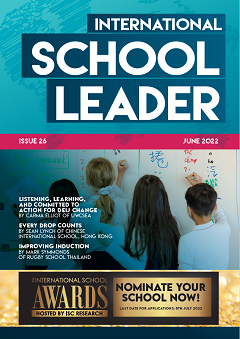At Vinschool Central Park in Ho Chi Minh City, Vietnam, we are implementing a school-wide initiative for embedding language support across the curriculum. We are aiming to create a sustainable model that can last as and when teaching staff change.
Language barriers
Like many schools, we recognised that language issues are often a barrier for students to master subject content. The vast majority of our students are Vietnamese and learn subjects such as mathematics and history through the medium of a second language. Our analysis concluded that providing language support in the mainstream classroom would greatly improve academic performance.
When moving to pedagogical paradigm to teach second-language learners (SLLs), it is useful to think of each subject as a subset of English. A subject such as biology has subject-specific vocabulary which is used in common collocations, and standard forms for discussing concepts. If this language is not broken down and made accessible to students, they may struggle to access the lesson.
In addition, misunderstandings about how to teach SLLs may result in a teacher ‘misreading’ a student; for example, apparent difficulties in ‘reasoning’ may in fact be due to their lack of familiarity with the linguistic properties of the language in which the reasoning is expected to be presented.
Effective language support
While the need to provide language support in international schools is often acknowledged, it is difficult to implement. The model of an international school, which aims to function largely as a school in the West would, is arguably a flawed one for teaching SLLs. Providing language support tends to be down the list of priorities, and it can therefore be a struggle to make it a central concern.
The most widely recognised pedagogical style for teaching language and subject content simultaneously is content and language integrated learning (CLIL). However, international educators are principally trained according to the national norms and expectations of their home country, and this training provides the normative basis for their daily work. Teachers from English-speaking countries working in international schools usually receive little or no training on CLIL methodology. Even when suitable training is provided, the skills can be lost when staff leave.
Furthermore, most teachers do not have access to materials that provide language support. For example, in England there is no endorsed body of classroom materials, resources, and pedagogies for the teaching of the curriculum at different stages of English language development. Therefore, teachers may need to spend a great deal of time designing and creating materials in order to have appropriate resources.
Our programme
We have designed our programme to be as comprehensive as possible. To this end, we provide in-depth professional development (PD), mentorships, a toolbox of activities and resources, and set methods to evaluate the use of language support. It was also important to make the programme cost-efficient, as it increases the likelihood of it being retained for years to come.
We chose to provide in-depth PD for teaching bilingual learners to select members of staff. We run the Cambridge International Certificate in Teaching Bilingual Learners as it provides theoretical and practical knowledge on how to provide language and cultural support in the classroom. A key part of the course is that each learner has a mentor. The idea is that these teachers will become expert practitioners who can pass on this knowledge when they become mentors to new recruits.
We also run smaller training sessions throughout the year for all teachers. The first of these is about the challenges of learning through an additional language. It is vital to get everyone on the same page in understanding our student body and their needs. One effective way to illustrate this is to focus on how teacher talk can obfuscate the lesson. This topic went down particularly well, as there are some really entertaining videos illustrating how English sounds to non-native speakers and confusing it can be.
We have provided teachers with a toolbox of CLIL strategies to implement in the classroom. One example is to analyse and identify the language functions the students will need to be able to express and understand it in English. In an ICT class, the sentence pattern ‘There are two ways that monitors differ from each other – size and resolution’ can be given to students as an example of classifying, while ‘Laser printers contain complex equipment, so they are expensive to repair’ is an example of consequence.
In another session, teachers were given a list of common CLIL activities, taken from key texts such as Teaching Other Subjects Through English by Deller and Price. We focused on activities that were relatively easy to integrate into normal lessons. One such activity is ‘Ask me about/tell me about,’ in which students are given different topics to ask and tell each other about in moving pairs.
Where available, we also sourced CLIL resource books. A particularly good series is 14+ Breakthrough to CLIL for IGCSE science, which our teachers use regularly to supplement their lessons. Another example is CLIL resources about global issues, which we use to supplement Global Perspectives lessons. We also encourage teachers to share their own resources on a shared drive.
Evaluating school-wide language support
To evaluate language support in the classroom we have a section in the weekly plan for detailing the provision being provided. We also evaluate language support during observations, and make a point of discussing lesson accessibility during feedback with teachers. In our bi-weekly meetings we also make time for teachers to share examples of language support they have recently provided.
I can say that, so far, our programme has had a significant impact on student performance, as shown by observations and the summer exam series. We are excited to see even better results as the programme becomes more embedded in the school culture.
There are five main aspects of our model, which we believe together form a comprehensive programme of language support. Each part is relatively easy to implement.
- Create a shared understanding of student needs: educate teaching staff on the challenges of learning through an additional language.
- Provide in-depth professional development: select teachers to take PD training on teaching bilingual learners, with the expectation that they will help to train new recruits.
- Run training sessions: provide teachers with easy-to-implement CLIL strategies and activities.
- Support teachers: generate a resource bank of CLIL-type materials, and hold supportive discussions with small groups of teachers in order to share learning.
- Evaluate language support: monitor the quality and effectiveness of language support in lesson plans and observations.
 David Richards is part of the Senior Leadership Team at Vinschool Central Park. Contact him directly at [email protected]
David Richards is part of the Senior Leadership Team at Vinschool Central Park. Contact him directly at [email protected]
Subscribe to ISL Magazine for more!



